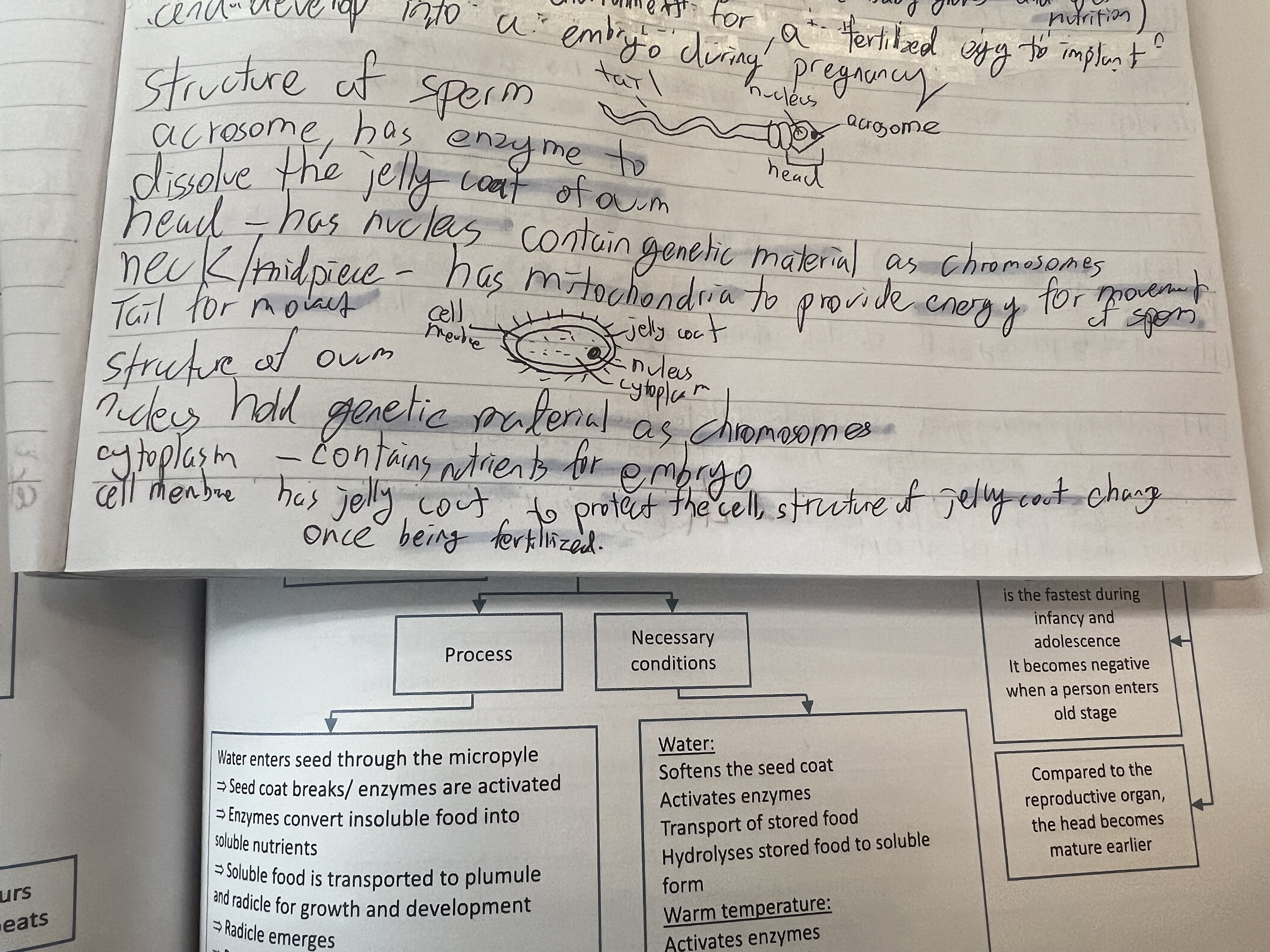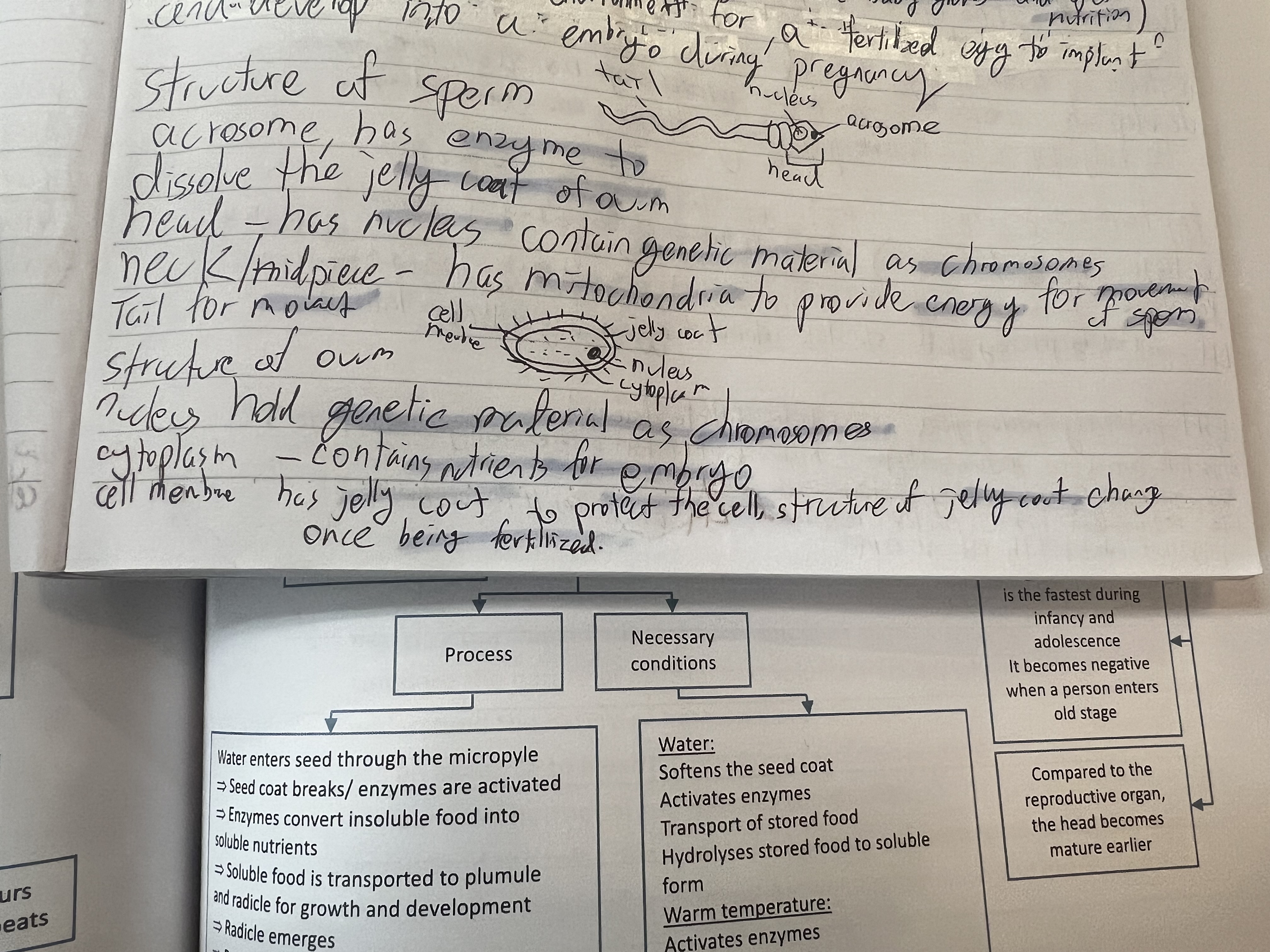Sexual reproduction in humans
1/22
There's no tags or description
Looks like no tags are added yet.
Name | Mastery | Learn | Test | Matching | Spaced |
|---|
No study sessions yet.
23 Terms
testis and Scrotum
Create sperm
Protect testis
Sperm duct and eppidleymis
Transport sperm out of tesis to urethra
Store sperm temporary and develop ability to move
Seminal vesicle
Urethra
Secrete seminal fluid give sperm nutrients
Urethra take out semen and urine out of body
Ovary and oviduct uterus
Produce egg cell and sex hormone
Transport egg to uterus (baby grow
Uterus develop into embryo during pregnancy
Structure of sperm
Tail for movement
Acrosome tip (has enzyme to dissolve jelly coat of ovum)
Head has nucleus contain genetic material as chromosome
Neck (has mitochondria to provide energy for movement of sperm

Structure of ovum
Cytoplasm:contains nutrients for embryo
Cell membrane:jelly coat to protect cell change when being fertilised
Nuclues hold genetic material

How is fertilisation occurred
Penis inject to vagina and eject sperm
Follicle in ovary bust to release ovum move along oviduct
Sperm swim through vagina cervix and uterus up to oviduct sperm meet ovum in oviduct penetrate it by enzymes to digest jelly coat of ovum and to prevent entry of other sperm
Nucleus of sperm fuse with ovum nucleus called zygote
Divide by mitocic cell division
Move down oviduct to uterus to implant and develop to embryo
What is menstrual cycle for
And when is ovum released
Prepare body for potential pregnancy
Released at 28 days remaining follicle cell become yellow body after ovulation(release of ovum)
Day 1-5 of menstrual cycle
If fertilisation don’t take place:Uterine lining break down and yellow body is appeared in day 28
If fertilisation menstruation won’t take place
Day 5/-14 of menstrual cycle
Uterine lining build up prepares it for implantation of fertilised egg
Day 14- ovulation take place (egg released from one ovary )
Day 14-28
If no fertilise egg made to uterus then uterus wall break down to stage 1 and repeats
If fertilisation occur implant to uterus lining and develop to foetus cylce stop as woman is pregnant
Oestrogen and progesterone
Both produced in ovaries -stimulated thickening of uterine lining for potential pregnancy (rise during first half of cycle leading to ovulation cycle )
Maintain uterine lining (if pregnant don’t occur uterine lining break down)progesterone level drop lead to menstruation
LH AND FSH
both produced in pituitary gland (stimulate release of egg) in day 14 ovulation
stimulate follicle development stimulate ovaries to produces more oestrogen as oestrogen increase inhibit FSH(negative feedback relationship) when oestrogen level rise stimulate release of LH which result in ovulation PROGESTERONE INHIBIT BOTH LH AND FSH
Identical and fraternal twin
1 zygote is formed separate into 2 embryo —2 zygote is formed separate 2 embryo different
Same genetic makeup —2 genetically different individual
Placenta function
Site of exchange of nutrients and waste
Produce sex hormones
Umbilical cord
Carry nutrients and oxygen to foetus and carbon dioxide away from foetus
Amniotic fluid
Acts as shock absorber
Allow baby move freely
Maintain stable temp for growth of baby
Prevent desiccation (drying up ) of embryo
Significance of parental care
Protect baby from danger
Food and protection provide to young offspring
Survival skills are taught to offspring
Breast feeding significance
Contain antibodies to protect baby from diseases
Help development of brain of baby
Stimulate recovery of uterine lining
Adv and disadvantages
Rhythm method
Withdrawal method
Condom
Avoid sex around ovulation Take out penis before ejaculation (sperm may leaked)
Prevent sperm entry
(cheap and natural ) (high failure rate)
(Cheap and protect std) (may tear on use
Diaphragm contraceptive pill and iud adv and disadvantages
Placed at cervix prevent sperm entry(reusable )(uncomfortable)
Prevent ovulation (reliable) (take everyday)
Prevent implantation (last long time) (uncomfortable
Vasectomy and tubal ligation adv and disadvantages
Cut and tie sperm duct (reliable )cannot reverse
Cut and tie oviduct (reliable ) (cannot reverse